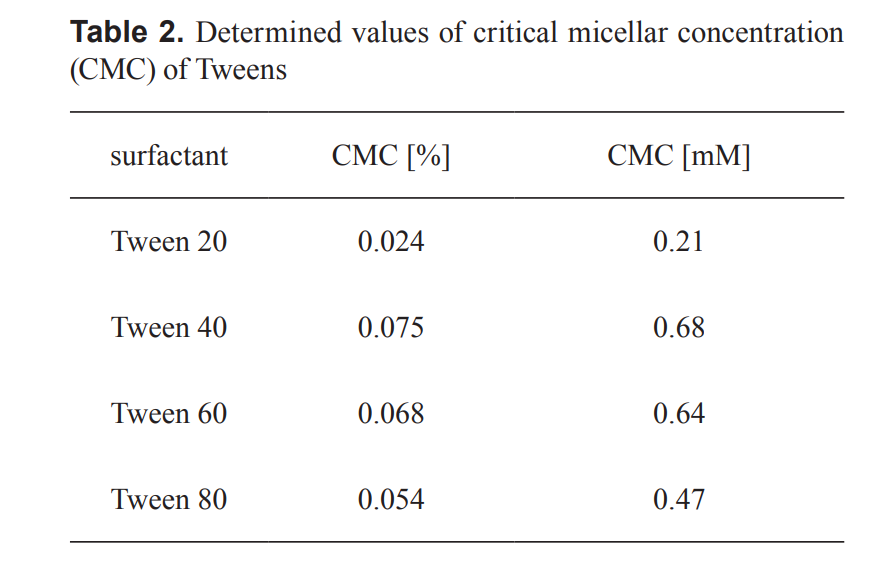Micellar-mediated extraction of green tea containing Chrysanthemum morifolium flowers
DOI:
https://doi.org/10.5604/01.3001.0010.7557Keywords:
Micellar-mediated extraction, Chrysanthemum morifolium, non-ionic surfactantsAbstract
Micellar mediated extraction (MME) is a new and alternative method of obtaining biologically active substances, such as flavones, flavanones, anthocyanins, triterpene from plant material. In this study a series of polyethoxylated sorbitan esters of fatty acids (Tween 20, 40, 60 and 80) have been applied for the extraction of green tea containing Chrysanthemum morifolium flowers. Results showed that all tested surfactants were effective in the solubilisation of flavonoids and phenolic compounds. Probably, because of too high hydrophilicity, Tween 20 was not sufficient to obtain antioxidants, in contrast to another Tween. It has been shown that method is economical, attractive and ecological.
Downloads
References
B. K. Paul, S. P. Moulik, Curr. Sci. India, 2001, 80, 990–1001. Google Scholar
F. H. Quina, W. L. Hinze, Ind. Eng. Chem. Res., 1999, 38, 4150–4168. Google Scholar
K. Madej, Trends Anal. Chem., 2009, 28, 436–446. Google Scholar
K. Kiathevest, M. Goto, M. Sasaki, P. Pavasant, A. Shotipruk, Sep. Purif. Technol., 2009, 66, 111–117. Google Scholar
K. Robards, K., J. Chromatogr. A, 2003, 1000, 657–691 Google Scholar
K. Śliwa, A. Tomaszkiewicz-Potępa, E. Sikora, J. Ogonowski, Acta Bioch. Pol., 2013, 60, 803–806 Google Scholar
K. Śliwa, E. Sikora, J. Ogonowski, J. Oszmiański, J. Kolniak-Ostek, Acta Biochim. Pol., 2016, 63, 543–548. Google Scholar
M. Choi, K. Chan, H. Leung, C. Huie, J. Chromatogr. A, 2003, 983, 153–162 Google Scholar
A. Tomaszkiewicz-Potępa, K. Śliwa, P. Śliwa, Chem. Transactions, 2010, 1-Ch, 343–352 Google Scholar
M. Kabir, Colloids and Surfaces A, 2003, 216, 65–74. Google Scholar
W. Liu, W. J. Zhao, J. B. Chen, M. M. Yang, M.M., Anal. Chim. Acta, 2007, 605, 41–45. Google Scholar
US Pat., US 0037115A1, 2005. Google Scholar
GB Pat., GB 1502895, 1978. Google Scholar
US Pat., PCT US 9605560, 1996. Google Scholar
Y. Bingjia, Y. Li, H. Qiong, S. Akita, S., Chin. J. Chem. Eng., 2007, 15, 468–473. Google Scholar
Z. Shi, X. Zhu, H. Zhang, H., J. Pharm. Biomed. Anal., 2007, 44, 867–873. Google Scholar
N. Pourreza, S. Elhami, S., J. Iran. Chem. Soc., 2009, 6, 784–788. Google Scholar
HU Pat., HU 20093, 1994. Google Scholar
K. Tsuji-Naito, H. Saeki, M. Hamano, Food Chem., 2009, 116, 854–859. Google Scholar
M. Ukiya, T. Akihisa, K. Yasukawa, Y. Kasahara, Y. Kimura, K. Koike, T. Nikaido, M. Takido. J. Agric. Food Chem., 2001, 49, 3187–3197. Google Scholar
Y-Y. Xie, J-L. Qu, Qi-L. Wang, Y. Wang, M. Yoshikawa, D. Yuan, J. Agric. Food Chem., 2012, 60, 12574–12583. Google Scholar
M. T. Yasuda, K. Fujita, T. Hosoya, S. Imai, K. Shimoi, J. Agric. Food Chem., 2015, 63, 7693–7699. Google Scholar
M. S. Hussain, S. Fareed, M. Ali, M. A. Rahman, J. Nat Pharm., 2012, 3, 4646. Google Scholar
W. Grajek, Przeciwutleniacze w żywności. Aspekty zdrowotne, technologiczne, molekularne i analityczne, WNT, Warszawa, 2007, pp 325-368. Google Scholar
M. Cybul, R. Nowak, Herba Polonica, 2008, 54, 68–78. 26. G. Shabir, F. Anwar, B. Sultana, Z. M. Khalid, M. Afzal, Q. M. Khan, M. Ashrafuzzaman, Molecules, 2011, 16, 7302–7319. Google Scholar
R. Perez-Roses, E. Risco, R. Vila, P. Penalver, S. Canigueral, J. Pharm. Pharmacol., 2015, 67, 666–672. Google Scholar
D. F. Cortes-Rojas, C. R. F. Souza, W. P. Oliveira, Sep. Sci. Techn., 2015, 50, 207–213. Google Scholar

Downloads
Published
How to Cite
Issue
Section
License
Copyright (c) 2017 University of Applied Sciences in Tarnow, Poland & Authors

This work is licensed under a Creative Commons Attribution-NonCommercial 4.0 International License.



